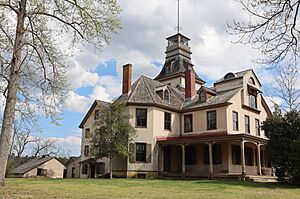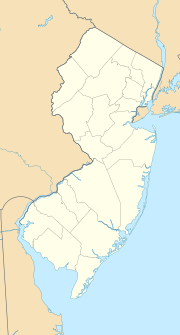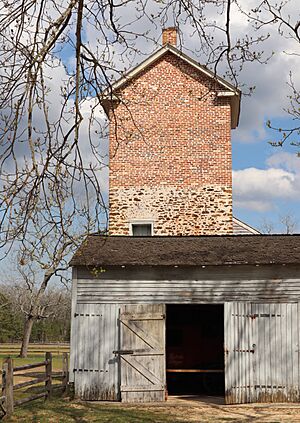Batsto Village, New Jersey facts for kids
Quick facts for kids
Batsto Village, New Jersey
|
|
|---|---|

Batsto Village Mansion in 2024
|
|
| Country | |
| State | |
| County | Burlington |
| Township | Washington |
| Elevation | 13 ft (4 m) |
| Time zone | UTC−05:00 (Eastern (EST)) |
| • Summer (DST) | UTC−04:00 (EDT) |
| GNIS feature ID | 874539 |
|
Batsto Village
|
|
| Location | 10 mi. E of Hammonton on CR 542, Batsto, New Jersey |
|---|---|
| Area | 1,200 acres (490 ha) |
| Built | 1687 |
| Architect | Joseph Wharton |
| Architectural style | Late Victorian |
| NRHP reference No. | 71000495 |
| Added to NRHP | September 10, 1971 |
Batsto Village is a fascinating historic community in New Jersey. It's located within Wharton State Forest in the middle of the Pine Barrens. This special place is part of the Pinelands National Reserve. It's so important that it's listed on both the New Jersey and National Register of Historic Places. The New Jersey Department of Environmental Protection helps manage and protect it. The name "Batsto" comes from a Swedish word, bastu, which means "bathing place." The first people to use this area for bathing were probably the Lenni Lenape Native Americans.
Contents
A Look Back: Batsto's History
Batsto Village has a long and interesting past, starting even before the United States was a country. It began as a place where people used the natural resources around them to create important goods.
The First Iron Works
In 1758, a man named John Munrow bought the land where Batsto is today. Later, in 1764, Richard Wescoat owned it. A year after that, Charles Read bought part of the property. Read was a smart lawyer and politician. He wanted to build a large iron-making business.
Read found that the area had lots of "bog ore." This was a type of iron ore found in streams and rivers. The nearby forests provided wood to make charcoal, which was needed to melt the ore. The Batsto River and other waterways offered power for the machinery. By 1766, Read had built the Batsto Iron Works, including a large furnace.
Batsto During the Revolution
In 1773, John Cox bought the Iron Works. They made useful items like cooking pots and kettles for homes. During the American Revolutionary War, Batsto played a crucial role. The Iron Works produced supplies that helped the Continental Army fight for America's independence.
The Richards Family Era
Joseph Ball, the Iron Works manager, bought the business in 1779. Then, in 1784, his uncle, William Richards, took control. The Richards family owned Batsto for the next 91 years. They built many of the village's buildings that you can still see today.
William Richards was the "ironmaster" until he retired in 1809. His son, Jesse Richards, took over and ran the works until he passed away in 1854. Jesse's son, Thomas H. Richards, then continued the family business. However, by the mid-1800s, people needed less iron. Batsto tried making glass instead, but it didn't last. Eventually, the village faced financial trouble.
Joseph Wharton's Vision
In 1876, a wealthy businessman from Philadelphia named Joseph Wharton bought Batsto. He also bought many other properties in the area. Wharton made many improvements to the village buildings. He also started new projects, like cranberry farming and a sawmill. He was interested in forestry and farming. After Wharton passed away in 1909, his properties in the Pine Barrens were managed by a company in Philadelphia.
Visiting Batsto Village Today
Batsto Village is now a popular historic site where visitors can step back in time. It's a great place to learn about life in early America.
How Batsto Became a Historic Site
By the late 1930s, only a few people, mostly woodcutters, lived in Batsto. In the late 1950s, the state of New Jersey bought all of Joseph Wharton's properties, including Batsto Village. The state then began to plan how to use and develop the area. The few remaining residents were allowed to stay until 1989, when the last house was vacated.
Work began to restore the village, including the large 50-room mansion. A dam was rebuilt to create a lake for recreation. As the restoration continued, Batsto was opened to visitors. By 1959, it was one of the most popular historic sites in the state. The historic village was officially dedicated on May 27, 1961. A visitor center was also built in 1961. It has an office, information desk, museum, and an auditorium.
What You Can See
Today, Batsto Village has more than forty historic buildings and sites. You can explore the grand Batsto mansion, a working sawmill, and a 19th-century ore boat. There's also a charcoal kiln, ice and milk houses, and a carriage house with stables. You can see a blacksmith shop, a wheelwright shop, a gristmill, and a general store.
The village's Post Office is still open! Many visitors like to get their mail hand-cancelled there, especially because it doesn't use a zip code. The Batsto-Pleasant Mills United Methodist Church, built in 1808, is still used for worship today. Batsto Village offers a unique chance to experience history firsthand.
See also





